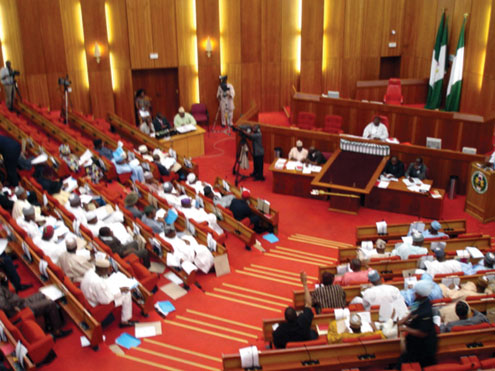Rescuing banks from web of bad debts
THE concept of banking, essentially, though nebulous, revolves around management of money, credit and investments. It is one of the oldest professions in the world and credit is at the heart of the business. The key functions of banking are anchored on exchange, account, business, savings, checking, loans, credit, finance, deposit, withdrawal, fund or capital, transaction, and issuing.
Nevertheless, in exercising its financial mediation role, the banks have landed in troubled waters. There is no denying the fact that non performing loans (NPLs), otherwise known as bad debts are largely responsible for the crisis in the banking sector. It has been discovered that they account for the distress of many banks in the country. Of concern, however, is the situation that governments of several countries have had to join forces with the industry regulators through the enactment of legislations to recover debts from mendicant debtors.
Currently, the bad debts in the industry stand in excess of N3 trillion. As at June, 2009, the total amount outstanding at the Expanded Discount Window (EDW) alone was N256.571 billion. The percentage of non-performing loans to total loans ranged from 19 per cent to 48 per cent.
According to NDIC’s 2009 annual report, out of the N178, 918.43 billion bad debts in the sector then, only N17.8 billion risk asset recoveries had been made.
In every part of the world, bank-debtor sour relationship has given birth to litigations. While special courts have been set up to handle the crisis, businesses have been foreclosed on default and individuals have been sent to prison terms and, in many cases, the lending institutions have collapsed with attendant job losses, government revenue, shareholders funds and more.
In Nigeria, the banking sector has been bedevilled with bad debtors. Not just bad debtors as they exist in other climes, but debtors who obtain credits with absolutely no intention of repayment. The debtors manipulate the system and muster every socio-cultural, legal, religious and economic powerbase to evade repayment.
Bad debts defined
The dictionary of banking describes bad debts as loans classified as a probable loss and has no economic values. They are receivable loans that have proven non collectable and are written off. In a nutshell, bad debts are receivable accounts receivable that will likely remain uncollectable and will be written off. They appear as an expense on the company’s income statement, thus reducing net income.
The highlights from these definitions are: bad debts are receivables; they are always non collectable; the debtors are usually insolvent; are usually written off; they are treated as expenses in the income statement; they are losses to the going concern, and such amounts are worthless to the creditor.
Causes of bad debts
There is no gainsaying the fact that banks survive on both creditors and debtors. The huge debt portfolio in banks is attributed to poor corporate governance practices, lax credit administration processes and poor risk management. Credits were released without collaterals and in some cases based on non-existing collaterals.
There are reports that many bank directors gave out credits to themselves and phony companies knowing fully well that such loans would never be paid back. In some cases, there were no clear structures on ground in banks on credit issuance. Apart from that, most of the banks lacked debt recovery strategies. The existing laws in the country make debt recovery cumbersome. Consequently, big debtors turned serial borrowers
Past and new offensive
Industry regulators, including the Central Bank of Nigeria (CBN) and Nigeria Deposit Insurance Corporation (NDIC) have at one point or the other evolved different measures and strategies to check the rising bad debt profile in the banking sector. How these efforts have met the specific objective is another matter all together.
Not too long ago, precisely in 1994, the military administration of Late General Sani Abacha rolled out the Failed Banks Tribunal (Recovery of Debts) Decree 18. The first of such financial sector legislation in the country’s history, the Decree sought and recovered hundreds of millions of naira from bank debtors as well as some bank directors. And of course, the jail houses were home to a handful of misbehaving bankers who lined their pockets with dubious loans as well as delinquent borrowers. The Failed Bank Decree was the fallout of the collapse of some 23 commercial banks in just one day in 1993. The financial regulators, CBN and NDIC, went after those who ran aground the institutions, the debtors in particular.
In 2009, the Senate released a document entitled: ‘Re: Schedule of Insider Credit of Banks Closed on 16th January, 2006’, submitted to it by the NDIC. The document unveiled the list of chronic debtors to some banks. In summary, the insider-related credit amounted to N53.3 billion, out of which the corporation was only able to recover N4.722 billion or 8.85 per cent.
The latest onslaught on the banks debtors was launched in the aftermath of the joint audit instituted in the banking sector by both the CBN and NDIC in 2009 which hinged the rot in the sector on frivolous granting of loans by bank chief executives.
This culminated in the sack of eight bank chiefs by the CBN Governor, Mallam Lamido Sanusi. He said the bank officials were removed due to high level of non-performing loans which was attributable to poor corporate governance practices, lax credit administration processes and the absence or non-adherence to the banks credit risk management practices.
The affected banks, he said, were net-takers of funds in the inter-bank market or enjoyed liquidity support from the CBN for long periods of time, a clear evidence of illiquidity.
The affected banks were Intercontinental Bank Plc, Oceanic Bank Plc, FinBank Plc, Bank PHB Plc, Afribank Nigeria Plc, Equitorial Trust Bank, Union Bank of Nigeria Plc and Spring Bank Plc.
The first step the apex bank took was to inject a bailout fund totalling N620 billion into the banks that failed the stress test to enable them remain in business. It then solicited the assistance of the relevant security agencies, particularly the Economic and Financial Crimes Commission (EFCC) to recover the huge debts owed the banks. The apex bank went ahead to publish names of big debtors that owed a total of N747 billion. In less than two months, the EFCC reported a recovering of about N171.045,670,248 billion from debtors of seven of the eight banks with bad loan portfolios. Also, the CBN instituted managements in the eight rescued banks embarked on aggressive debt recoveries which recorded resounding success.
To further drive its point home, the CBN facilitated the establishment of Asset Management Corporation of Nigeria (AMCON) which was essentially to soak up the bad debts in the sector.
AMCON initiative
To underscore the importance attached to cleaning the banks’ books from bad debts and making them able to extend credits to the private sector, the CBN and other relevant agencies facilitated the setting up of a state-owned Asset Management Corporation of Nigeria (AMCON) to take care of the bad debts in the banking sector.
AMCON recently concluded the acquisition of all non performing loans in the banking sector. The corporation issued N600 billion worth of bonds to 22 banks to absorb all remaining non-performing loans, in addition to the N1.03 trillion it issued on December 31, last year. Only last week, the corporation listed N1.7 trillion bonds backed by government guarantees on the Nigerian Stock Exchange (NSE) to soak the remaining bad debts in the sector. It is also working assiduously towards returning the bailed out banks from negative shareholders’ fund to zero, to make them attractive for a merger or acquisition.
Effect on the economy
Failure of any bank has untoward effect on not just the depositors but the economy at large. Bank collapse comes with losses in government revenue and shareholders’ funds. It also leads to job losses and displacement with attendant negative effects.
Conclusion
The issue of loan administration and risk management now take centre stage in the sector. The era of granting frivolous loans is gradually becoming a thing of the past. There is a new era of full disclosure, transparency, international standards of financial reporting, stringent risk management, good corporate governance and all that. With pressures from the market regulators, depositors and shareholders, the banks are subjecting chronic debtors to justice. Existing credit contracts are being reviewed by bank lawyers to find avenues for foreclosures.
The coming of credit bureaus in the financial sector is also helping to put a check on the activities of serial borrowers and by extension, sanity in lending.
source : Tribune








